TRANSLATION OF N° 229
SWORN STATEMENT
Being aware of the criminal consequences of a false sworn statement, I, Franz Krause, born on 16 June 1904 in Gedaithen, Krs.Allenstein, East Prussia, residing at …, make the following report, the correctness and truthfulness of which I confirm under oath.
From October 1943 to March 1945, I was the chief squad leader (sergeant- major) of headquarters company 1st division of the tank regiment of the ‘Viking’ division. In early May 1944, I was assigned to the tank regiment as leader of the support point. ‘Support point’ means the management of material reserves, devices, clothing, etc. I received the order to construct the support point in the Auschwitz concentration camp, while the division was on the troop exercise ground at Heidelager (Debica, Poland). In the Auschwitz camp, a barracks, in which I could store the materials, was made available to me by the
administration.
My stay right there lasted 10 weeks, so that I used the opportunity to allow my wife and 5 years-old boy to come stay with me. The dwelling made available to me by the camp administration was located in an individual dwelling house. Since I had enough time, I walked around the camp to get to know it. No restrictions were imposed upon me by the camp administration.
I remember especially well that I heard music and went over to see where it came from. In front of the local administration building stood thousands of inmates standing in march formation and marching along the camp road to the armaments factories located outside the camp under the direction of Kapos (prisoners) to the sound of music. Towards evening, they returned to the camp. This was repeated every day during my stay. I have established that the inmates were well fed and their behavior was also good.
I made the same observation in the women’s camp. To the song of ‘High on the Yellow Wagon’, they marched to the local agricultural experimental installation, which was under the direction of Thies Christophersen. I remember that the women came from the adjacent camp of Birkenau.
During my inspections, I discovered a camp with suitcases. Since I had only escaped with my naked life from the Tscherkassy encirclement, I went to camp commandant Baer to ask if he could give me a suitcase. Baer refused. In a second conversation, he explained to me that the suitcase belonged to the prisoners and that he could not dispose of them. He reported to me upon the occasion a commission had examined the lodgings of the camp personnel a few weeks before. If anything was found which belonged to the inmates, the person was sent to the SS punishment camp at Matzkau near Danzig. Baer did not wish to risk such a punishment for the sake of a suitcase. I never forgot that statement.
During my wanderings through the Auschwitz camp, I never saw a gas chamber, nor did I perceive any stench of burnt corpses. The columns of smoke that I saw came from the surrounding armaments manufacturing plants.
If people object that thousands, or even tens of thousands, of prisoners were gassed or burnt during this period, ‘I must reply that such proceedings could not have remained concealed from me. At any rate, I never saw or heard anything about it! A sub-squad leader from the administration lived in our neighborhood, with whom I often conversed about everything possible. Our wives became close friends and visited each other. There was never any mention of gassing of inmates. We also visited a musical event in the camp.
On the whole, I got to know Auschwitz as a decent labor camp.
I had no contact with the inmates themselves, they were on labor service during the day, so that the camp was almost empty. I never saw anything in the way of brutality of the SS against inmates. Only once, I saw a labor commando hoeing weeds in the camp, the supervising Kapo was very aggressive and kicked several inmate.
This my report of the major impressions which have remained in my memory.
Signed, Franz Krause.
N° 11 of the role of sworn statements for 1991, notary public Helmut Meyer, Einbeck, 7 March 1991.
END OF TRANSLATION OF SWORN STATEMENT
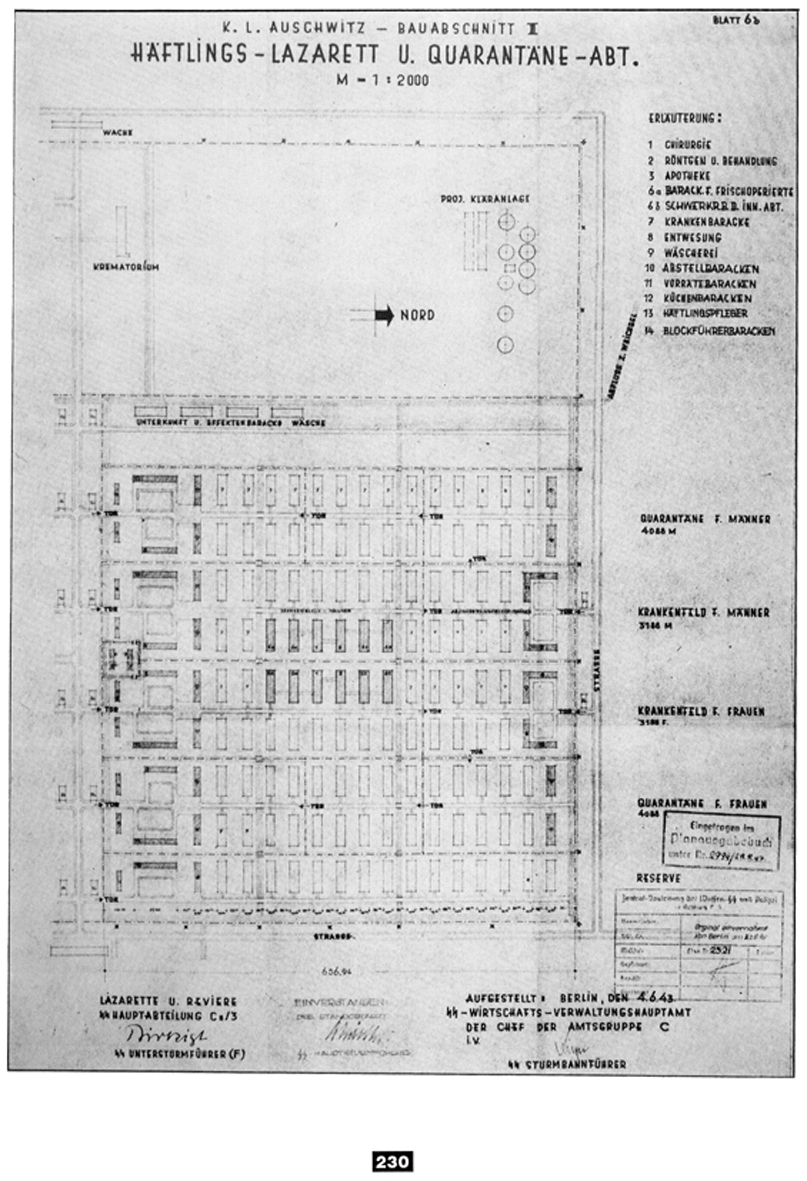

(230 and 231) Blueprint 2521, drawn up on 30 June 1943 in the Economic Main Administration Office of the SS in Berlin, provided for the construction of a new camp section B III for the reception of approximately 16,000 sick inmates as well as a quarantine section. Partial translation:
"
Auschwitz Prisoner of War Camp - Infirmary
30 beds, 24 beds, 48 beds", etc.
This fits in very poorly with the theory that Auschwitz was planned as an extermination camp.
Pressac points out that a later blueprint, dated 7 December 1944 (barely two months before the liberation of the camp) designates BIII as the intended location for ’60,000 prisoners’. This is no way changes the fact that in June 1943, that is, shortly before the termination of Crematoria II to V, blueprints were drawn up for the reception and care of 16,000 patients and proves only that this plan was later changed for some reason.
(232) Paul Rassinier, (233) Maurice Bardeche, (234) Thies Christophersen, (235) Wilhelm Staeglich, (236) David Irving, (237) Udo Walendy, (238) Arthur Butz, (239) Robert Faurisson, (240) Fred Leuchter, (241) Robert Faurisson, Fred Leuchter, Mark Weber, (242) Juergen Graf, (243) Jean-Claude Pressac, (244) Germar Rudolf
Doubts as to the correctness of the innumerable atrocity tales on the Second World War arose very soon after the war.
One of the trail-blazers was the Frenchman Paul Rassinier, who was himself interned in Buchenwald as a resistance fighter. Author of several books, The Lies of Ulysses (1950), Ulysses Betrayed by His Own (1961), The True Eichmann Trial (1962), The Drama ‘tragedy’ of the European Jews (1964). These books are worth reading even today. The Lies of Ulysses provides a profound insight into the way in which German concentration camps actually functioned.
The short text the Auschwitz Lie, published in 1973, was like a bolt out of the blue. In this book, the agronomist and former Wehrmacht soldier Thies Christophersen, who was assigned to Raisko, an Auschwitz satellite camp as an agricultural expert after being wounded in France, describes what he saw there and how he investigated the wild rumors current among the inmates. He stated that he never saw any gas chambers and testified that the treatment of the inmates in Raisko was very humane.
Although it was a very modest text, the effects were enormous. 100,000 copies were sold, including the translations. The book inspired many other researchers, like Ditlied Felderer, Wilhelm Staeglich, Arthur Butz, etc…, to examine the question.
In the meantime, many other researchers had also gone to work.
One obstacle, of course, was that Poland was still Communist and independent researchers were hardly allowed into Auschwitz and Birkenau. The communists had established the correct version of history – apparently forever.
But the Poles were not suspicious of Ditlied Federer. As a Jehovah’s Witness, he was investigating the fate of other Jehova’s Witnesses who had died in Auschwitz and other camps. He was also accompanied by his beautiful Philippino wife, whom the Poles mistook for a Vietnamese, that is, the citizen of an allied state. Felderer very soon discovered that something was rotten in the official version of history. He took thousands of photos and interrogated almost everyone he ran into. He thus performed significant research work, the results of which he sent to the German-Canadian Zündel.
In Germany, the former judge Wilhelm Staeglich published his book. The Auschwitz Myth in 1978. Another classic, written by the American professor of electronics and computer sciences, Arthur Butz, had already appeared in 1946. Both books are indispensable for anyone seriously interested in revisionism, even today.
In many countries, texts appeared which disputed the official version of the Holocaust. Leading the way was the Institute for Historical Review in Los Angeles, which held revisionist conferences and printed or published numerous books. Some of their most prominent writers are Mark Weber, Tom Marcellus, Greg Raven, Bradley Smith, Friedrich Paul Berg, Arthur Butz, J-M Boisdefeu and Enrique Aynat.
In Germany, Udo Walendy began the revisionist periodical Historische Tatsachen, 72 issues of which have appeared.
In France, the Annales d’Histoire Revisionniste were the first to appear, followed, later, by the Revue d’Histoire Revisionniste.
Prof. Robert Faurisson was the charismatic leading figure in this movement. He attacked the touchy topic with academic exactness and incredible courage. For doing so, he lost his position as professor and continues to be persecuted by the justice system to the present day. So far, he has been the victim of seven physical attacks.
Faurisson first worked through the most important source material. He then undertook research at the archives of the Centre de Documentation Juive Contemporaine in Paris, the National Archives in Washington, the Auschwitz State Museum at Auschwitz and the Bundensarchiv Koblenz. Naturally, he also visited the most important locations of the alleged genocide of the Jews. He the visited the gas chamber in the state prison at Baltimore and Maryland in order to form an exact idea of the procedures utilized in executions with cyanide gas.
Faurisson was the first researcher to find the blueprints of the crematoria I, II and III in the Auschwitz archives, which he published. On the blueprints, the alleged gas chambers are designated as ‘morgues’. He discovered that the four openings in the roof of Krema I, as well as the only door leading directly into the ‘gas chamber’, did not exist at the time of the alleged mass gassings and therefore could only have been pierced through the roof of Krema I since the liberation of the camp.
Execution gas chambers were invented in the USA and used because the intention is to cause painless death. The planning and realization of the execution is, however, anything but simple. The procedure is so risky, so detailed and expensive, that this method is increasingly being abandoned and being replaced by lethal injection.
A gas chamber must satisfy innumerable requirements.
Revisionist research expanded enormously when Faurisson made contact with the worldwide leader in gas chamber technology, Fred Leuchter, during the 1988 Zündel and Faurisson asked Leuchter to draw up an expert report on the rooms designated as gas chambers at Auschwitz, Birkenau and Majdanek, which at that time still lay behind the iron curtain. He was to determine the capacity of the crematory ovens.
The Holocaust lobby later attempted to bring Fred Leuchter into discredit. They claimed that he had lied about his engineering credentials and had been bribed by the revisionists, quite apart from the fact that he was, of course, smeared as a ‘Nazi’. The Holocaust lobby nevertheless proved itself incapable of a technical rebuttal of the conclusions of the Leuchter report.
The Leuchter report had dealt a heavy blow to the Holocaust legend, other expert reports in support of Leuchter’s conclusions then followed.
Of particular significant are the Rudolf report, after the German chemist, the evaluation of air reconnaissance photographs (Air Photo Evidence) by the Canadian geologist and air photography exert John C. Ball.
As their last card, the defenders of the orthodox version of the Holocaust then backed the French pharmacist J.C. Pressac, hailed by the media to be a converted revisionist. This is not true: Pressac did, it is true, undertake research work with Robert Faurisson, but never endorsed Faurisson’s conclusions and never published any revisionist work of his own.
His monumental work Auschwitz: The Technique and Operation of the Gas Chambers is very important from a documentary point of view. For the revisionists, it represents a true mine of information, which they use extensively. From a scientific point of view, however, the work is worthless, because the author mixes reliable sources with pure fiction in the most irresponsible manner in order to reach the desired result. He does not examine opposite points of view and never cites technical literature.
Whenever Pressac stumbles across a fact which contradicts his hypothesis, he simply ignores it. The entire work appears to have been written by someone who can no longer see the forest for the trees. The same is true to an even greater extent of his second, much shorter book, Les Crématoires d’Auschwitz. La Machinerie du meurtre en mass.
The defenders of the official version of the Holocaust need not fear any sudden upswing in revisionism, of course, since disputing or even disputing the Holocaust has been made a criminal offence in several European countries. The worst countries are Germany and Austria, where revisionists risk lengthy prison sentences. Even in France, legal proceedings are regularly taken against revisionists, but the authorities are content to levy heavy fines, which ruin the defendants.
- MISCELLANEOUS
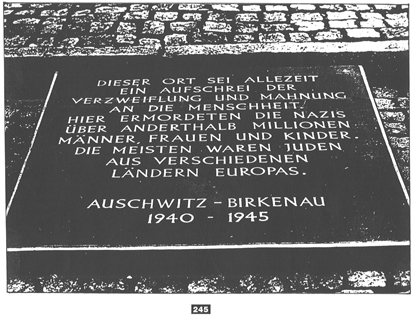
(245) Tables at Auschwitz, engraved in 19 languages, stating that 4 million victims had died. This falsification of history was to stand unquestioned for 45 years.
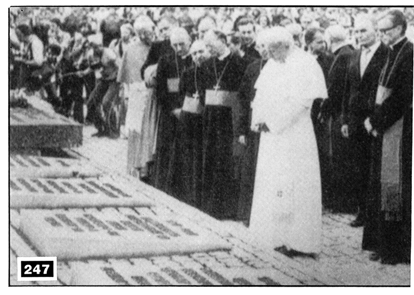
(247) The Polish Pope John Paul II doing obeisance before a lie; he certainly knew the truth, because the Polish church was kept informed on events in the camp on a daily basis.
(248) The trial of the German-Canadian revisionist Ernst Zündel lasted many years (1983 to 1992) and resulted in much valuable revisionist research. The trial led to discussion of the Auschwitz ‘death books’, hidden by the Soviets. As a result of this trial, the Soviets were finally compelled to transfer the death books to the Special Class Office ‘Sonderstandsamt’ in Arolsen, which now keeps them under lock any key.
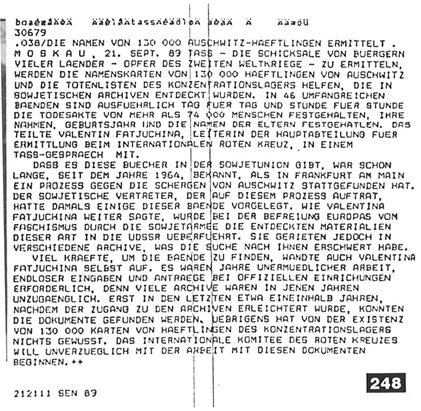
TRANSLATION OF TELEX OF NEWS AGENCY
306709
03/Names of 130,000 Auchwitz inmates discovered in Moscow, 21 September 1989 TASS-the name cards of 130,000 Auschwitz inmates and the death lists of the concentration camps, which were discovered in the Soviet archives, will help discover the fate of citizens of many countries who were victims of the Second World War. 46 extensive volumes contain the detailed death certificates of over 74,000 people, day by day, hour by hour, stating the name, year of birth and the names of their parents. The announcement was made by Valentina Fatjuchina, leader of the main division for the investigation of the Red Cross, in a Tass discussion.
That these books existed in the Soviet Union, has been known since 1964. During a trial of the butchers of Auschwitz in Frankfurt-am-Main, the Soviet representative who appeared during the trial presented a few of these volumes. As stated by Valentina Fatjuchina, the material discovered during the liberation of Europe from fascism by the Soviet Army was transferred to the USSR. They were then housed in various archives, which made the search for them more difficult.
Many persons in search of the volumes addressed themselves to Valentina Fatjuchina herself. It took years of untiring work, endless entries and applications to official agencies, since many archives were not accessible in those years. It was only in the past one and half years, more or less, after access to the archives was facilitated, that the documents could be found. Furthermore, nothing had been known of the existence of 130,000 cards of inmates of the concentration camp. The International Committee of the Red Cross will begin work on these documents immediately.
END OF TRANSLATION OF TASS TELEX
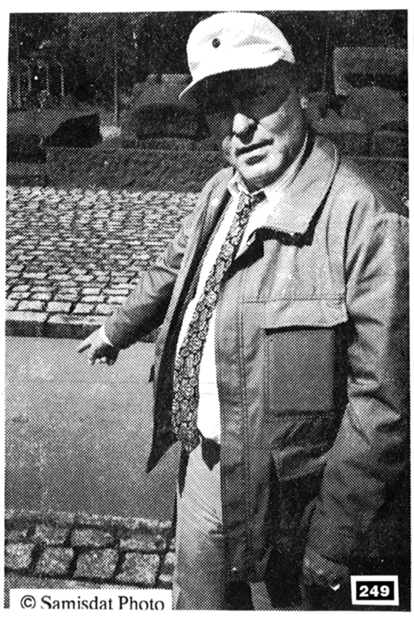
(249) Ernst Zündel proudly pointing to the former location of the stone tablets stating that 4 million people died in the camp. The tablets had just recently been chiseled away and dumped in the Memory Hole. A few years later, a new text appeared, showing 3 million fewer victims. The official myth of the genocide of the Jews speaks of 1.5 million Auschwitz victims.
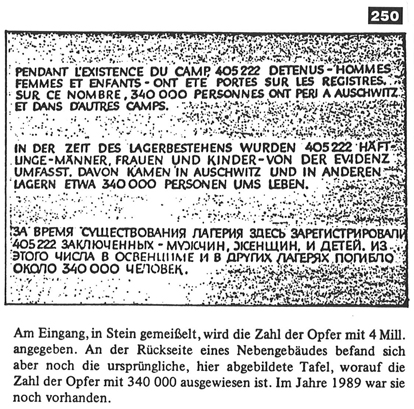
(250) Plaque mentioning the exact number of 340,000 victims near the entrance to the camp. Revisionist research appears to indicate approximately 120,000 victims.
TRANSLATION OF TABLET
During the existence of the camp, 405,022 prisoners, men, women and children, were entered on the registers. On this number, 340,000 persons perished at Auschwitz and other camps.
TRANSLATION OF CAPTION TO ABOVE ILLUSTRATION
At the entrance, chiseled in stone, the figure of 4 million appeared. On the rear of an adjacent building, however, is the original tablet shown here, indicating a figure of 340,000 victims. In 1989, it was still there.
END OF CAPTION

(251) this photograph of Jews being rounded up for deportation has appeared countless numbers of time in the media, for its emotional impact. It is usually accompanied by the allegation that the little ghetto boy was gassed with his entire family. In reality, he is now lives in the USA. His name is Tsvi Nussbaum. He was deported to Bergen-Belsen with his family. After the war, he emigrated to Israel and in 1953 to the USA.

(253) Reading the memoirs of former concentration camp inmates, the question necessarily arises as to their objectivity.
Thus, the Belgian Regine Beer (253 right) claims that she was forced to carry 50 kg sacks of grain at a time when she herself weighed only 40 kg! During her six-month term of imprisonment at Auschwitz, she fell ill three times. Yet she was never subjected to a selection or sent to the gas chamber! Instead, she recovered, although the conditions in the hospital are supposed to have been truly terrible. Really a Superwoman!
She does not reveal why she was deported, since her mother and two sisters were left in peace in Belgium. The Beers were not Jewish. The veil of secrecy is discretely lifted a bit on page 40, however, when she says: “It’s possible that the Germans knew about my occasional resistance activity”.
Was Regine Beer really naïve enough to believe that the Germans would be pleased with these activities? She only describes her term of imprisonment at Auschwitz during the second half of 1944, a period of six months at most. Of her personal background, she says very little, but waxes eloquent at great length about quite ordinary conditions which were to be found in any concentration camp. Her book is obviously the work of a woman who was very little to say, but who has been promoted to the skies as a symbolic figure. It is remarkable that she never saw what she simply MUST have seen ‘if the Holocaust is a fact’.
She reports that she worked in the kitchen of the women’s camp (position 21 on figure 118), when the Hungarian Jews arrived, these are supposed to have been mostly gassed and burnt. This happened only 30 meters from the kitchen, where she had a clear view of the scene of the crime, but Regine Beer wastes not a single word on this monstrous tragedy or her personal feelings in this regard, although she must have been an eyewitness of the first rank.
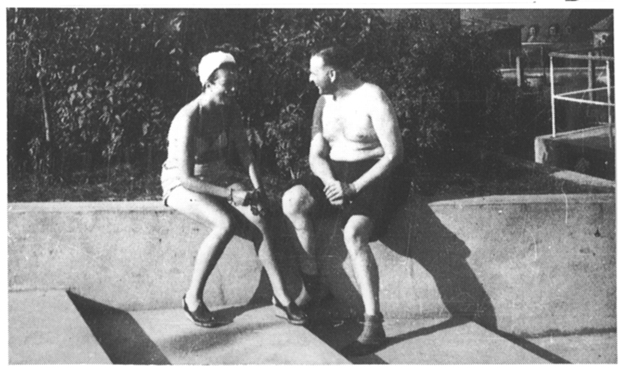
(254 – 257) Stephen Spielberg’s film Schindler’s List shows camp commander Goeth shooting at inmates in the camp from his villa on a hill into the camp. This is a gross falsification on Spielberg’s part. Goeth’s dwelling was, in fact, not located on a hill at all, but in a depression below the camp, offering no view into the camp at all. For Goeth to have shot into the camp from dwelling would simply have been impossible.
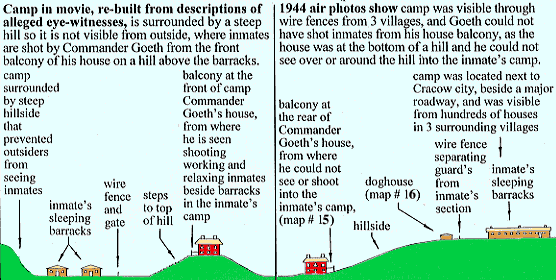
(254) on the basis of air photos of the Plaszow camp, John C. Ball proved that Goeth dwelling was located on the other side of the camp, behind a hill. He could not, then, as graphically depicted in the film, shoot at inmates in the camp from his dwelling. This means that the Auschwitz liars are, once again, simply lying to millions of movie-goers, who allow themselves to be treated with contempt in this fashion.
This is only one of the many swindles in Spielberg’s film. Spielberg even has the shamelessness to insinuate that sometimes water issued from the shower heads and sometimes gas. This allows the movie-goer to gain the impression that Zyklon was like city-gas, which could flow through pipes! Naivety and superstition are as pervasive in the 20st century as in the darkest of the Middle Ages.
From the film:
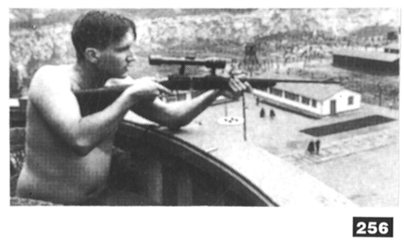
(256) Spielberg depicts the SS camp commandant as slim and snappy, a real Hollywood Nazi. In reality, Goeth was a middle aged-man, balding with a pot belly. He was, in fact, a passionate marksman, but shot at birds, not prisoners.
In reality:

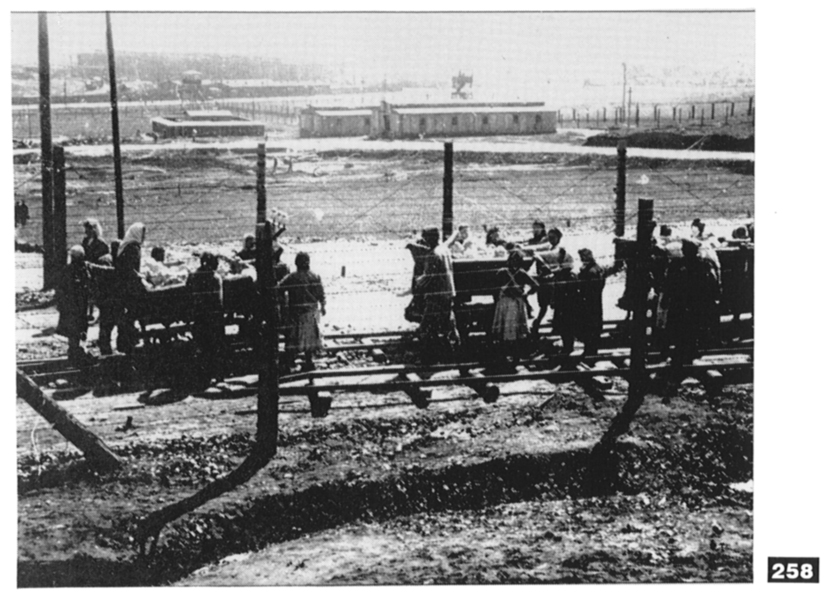
(258) Women inmates on rest break in the Plaszow camp, before pushing the stone-laden carts up the hill. There are no Kapos with whips in sight. In this regard, compare the illustrations 210 and 211.
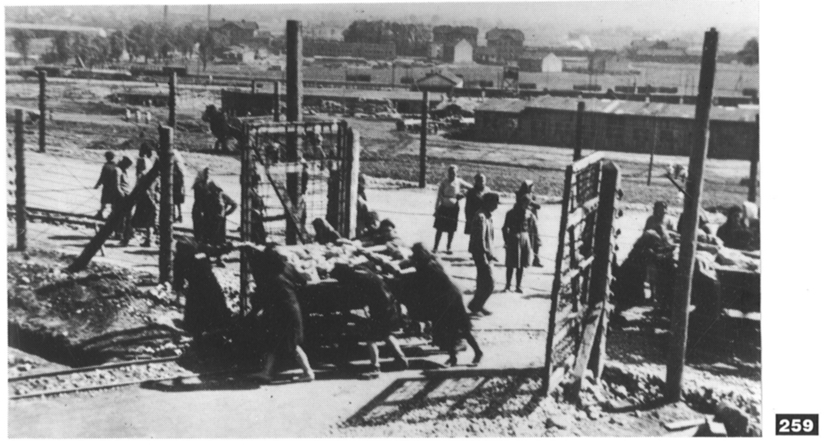
(259) This shows the inmates pushing the carts uphill. A few onlookers stand around in the background. A quite normal photograph of people of people at work.
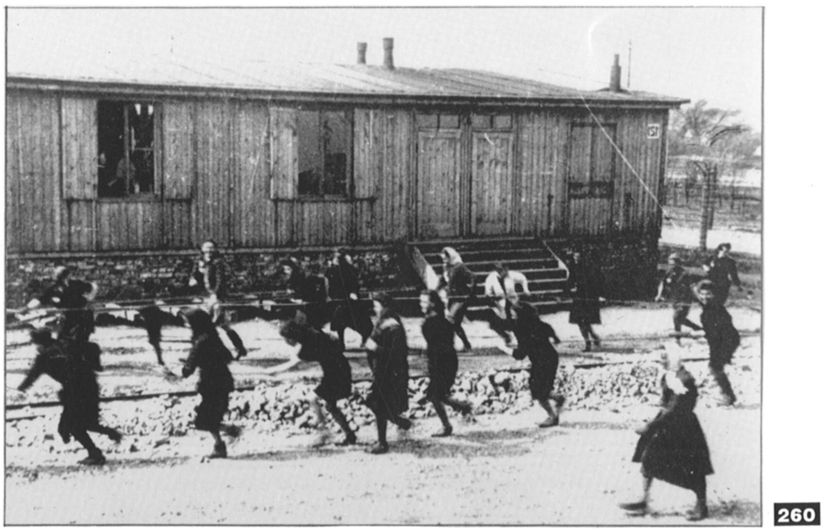
(260) Laughing women pulling now empty carts back down the hill.
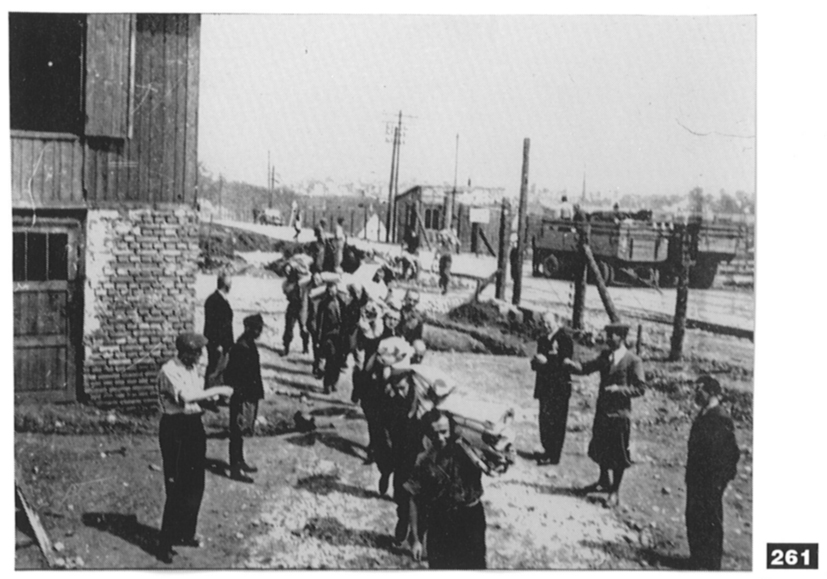
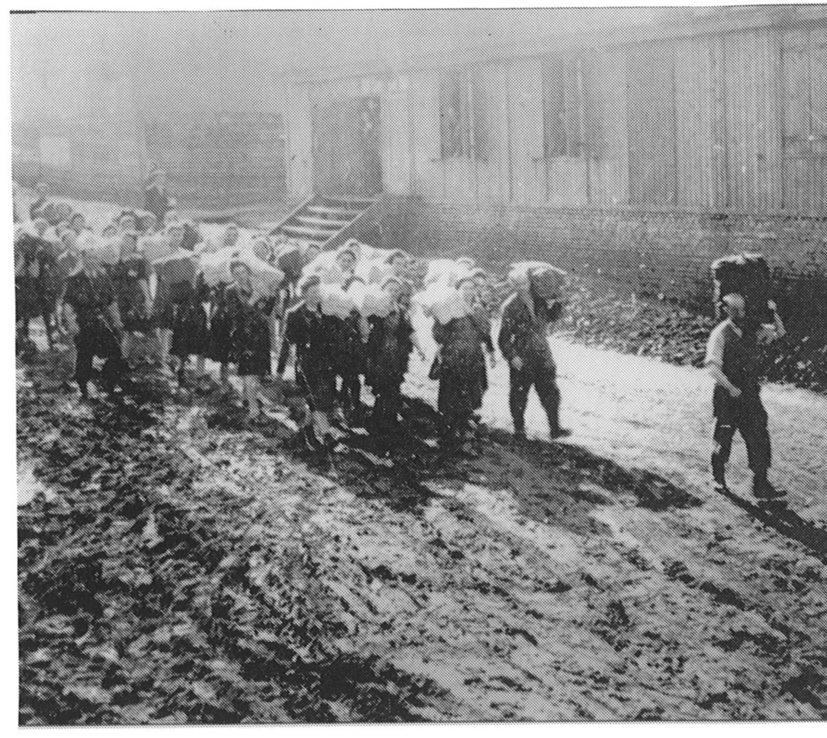
(261 and 262) the arrival of new, mostly Jewish prisoners (Plaszow camp). They are receiving bedclothes and necessary possessions. Civilians and one Kapo look on. The road on photo 262 is slippery and not yet paved or asphalted.
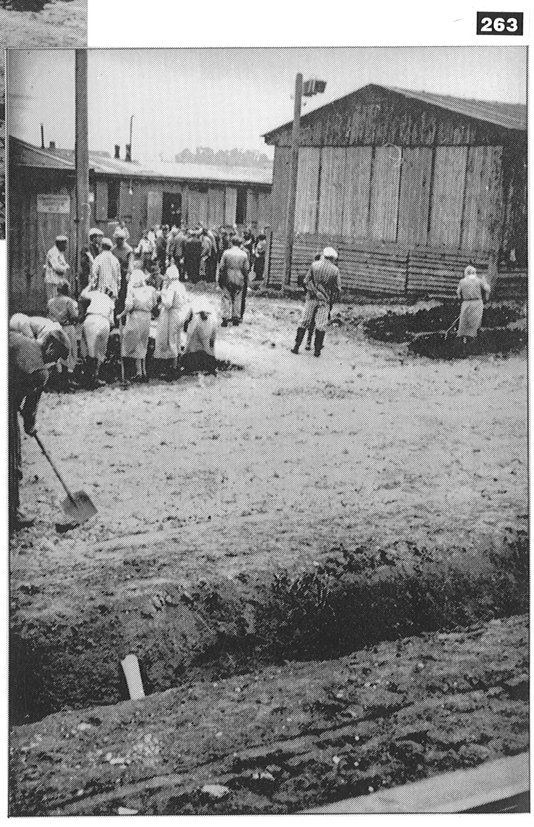
(263) Male and female inmates working together to improve the roads in Plaszow camp.
Camp commandant Goeth was placed on trial by the Poles after the war and hanged.
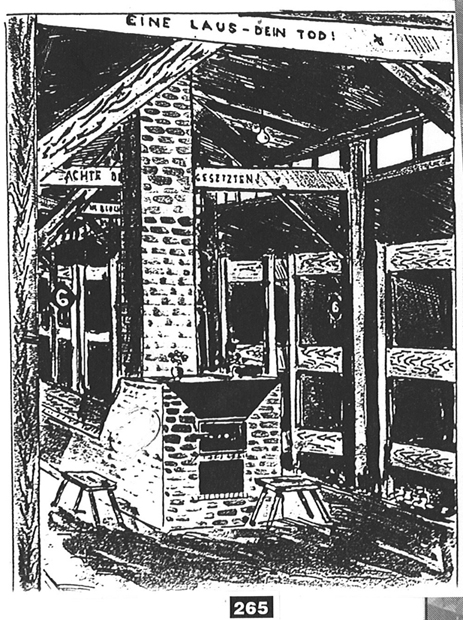
(265) One of the barracks at Birkenau seen from the inside. In the middle is a type of central heating installation, running the entire length of the building. It is also equipped with toilets and wash basins with running water, a dining room and offices for the block leader and his subordinates.
Signs: "One Louse = Your Death", "Respect Your Superiors"
There are many indications that the camp administration wished the conditions to be as satisfactory as possible under the circumstances. Note the warning signs: “One Louse Means Your Death”, “Respect Your Superior”, “Keep Calm”, etc… There were large showers with hot water, a post office, a library, a brothel as well as relaxation facilities. The reality was therefore often quite different from the claims that are made, but not always. Many camps were administered rationally and in humane manner.
Camp commandants and other officials who were guilty of misconduct were sentenced by SS courts and executed (such as Buchenwald commandant Karl Koch).
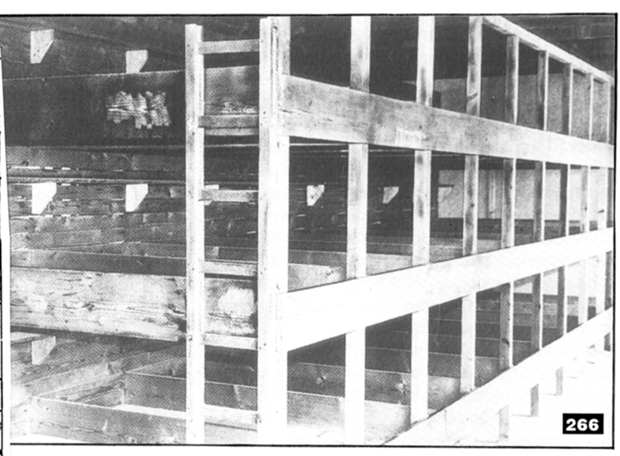
(266) The barracks shown here were entirely without anything providing and short of comfort. In actual fact, most of the Russian prisoners of war, for example; had never experienced anything of the sort, because living conditions were worse in Russia.
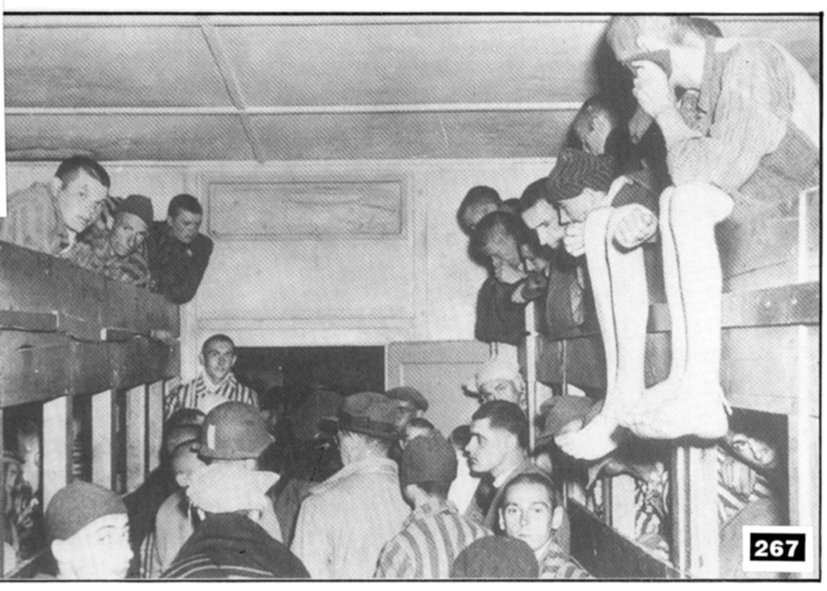
(267) Barracks in Dachau after the liberation. Note that, even during the chaotic last months of the war, efforts were made to maintain order and cleanliness in the camps.

(271) After the war: millions of German prisoners of war had to survive for months in the rain, cold and wind in holes under the open sky. According to the Canadian James Bacques, up to one million prisoners of war died of deprivation.
Many preferred to work and sleep in the coal mines, because they were somewhat better fed there and to a certain extent, protected from the weather. These men would have been quite happy in an Auschwitz- type barracks!
“It was deliberate US Army policy not to provide any shelter or other comfort in the prisoner cages.” Saturday Night-September 1989.
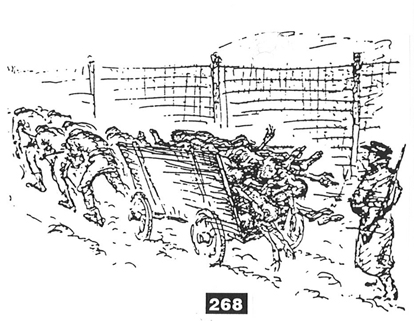
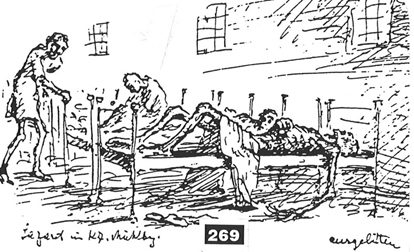
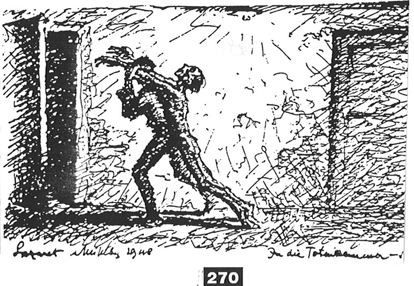
(268 – 270) There is a great deal of literature on the numerous camps German prisoners of war, as well as for the hundreds of thousands of ethnic from Eastern Europe. The controlled media, however, are only concerned with the fate of the Jews.
In his paintings and drawings, Otto von Kursel depicted his impressions of an American concentration camp on German soil.
(272) Among the revisionists, Walter N. Sanning has dealt with the demographic aspects of the alleged Holocaust in the greatest detail. He estimates the number of the Jews who disappeared in the German sphere of influence at 300,000, plus approximately 400,000 in the Soviet sphere of influence.
(273) Walter N. Sanning attributes the general disappearance of the European Jews to the following circumstances in particular, a large proportion of them emigrated, mostly to the USA, Palestine, or other countries, on the one hand. On the other hand, according to Sanning, most of the Polish Jews fled into the USSR, where they were deported further East on Stalin’s order’s, or, if they were fit to perform military service, conscripted into the Red Army. Finally, very many Jews still live in Western Europe even today (officially, more than 700,000 in France, there are large Jewish communities in Britain and Belgium).
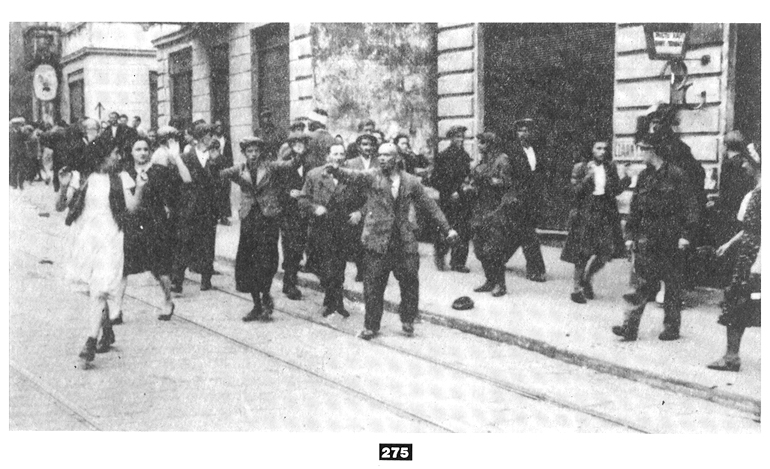
(275) Many Jews died even before falling into German hands. After the withdrawal of the Red Army and the approach of the German Army, there was a general settling of accounts ‘with the local population’. The local population of the regions involved (Eastern Poland, the Baltic, the Ukraine), blamed the Jews for the crimes of the Bolsheviks. The Jews had, in fact, occupied a large proportion of key positions in the communist power apparatus.
This picture shows an anti-Jewish pogrom in Lemberg before the arrival of the Wehrmacht.
The victims of these pogroms were later said to have been killed by the Germans.
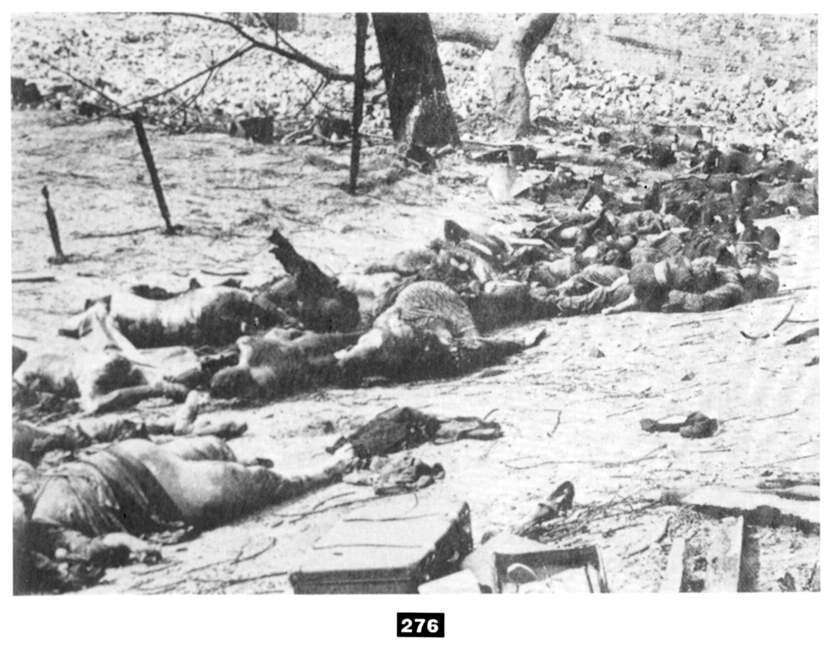
(276) During the Soviet conquest of the German Eastern territories, million of people fled as refugees, civilians, soldiers, prisoners of war, forced labors, camp inmates. They were all shot at indiscriminately and many died.
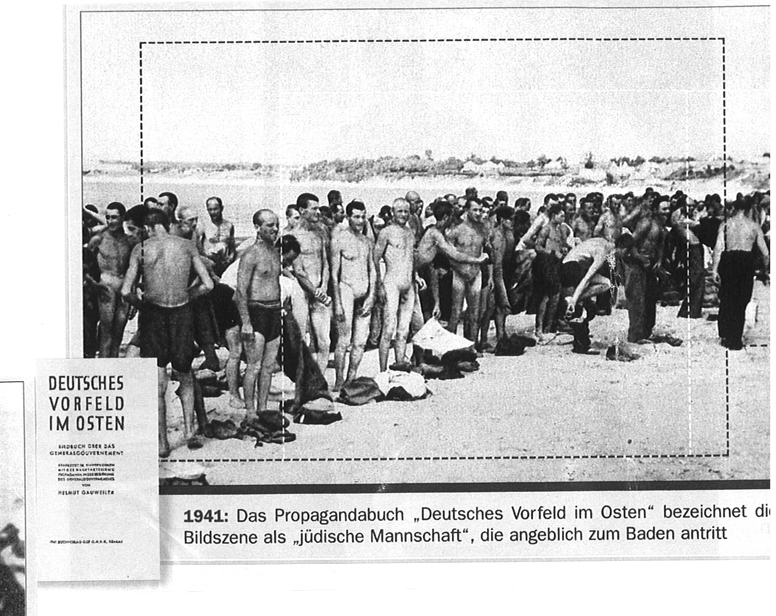
Original pricture: prisoners undressing to go for a swim
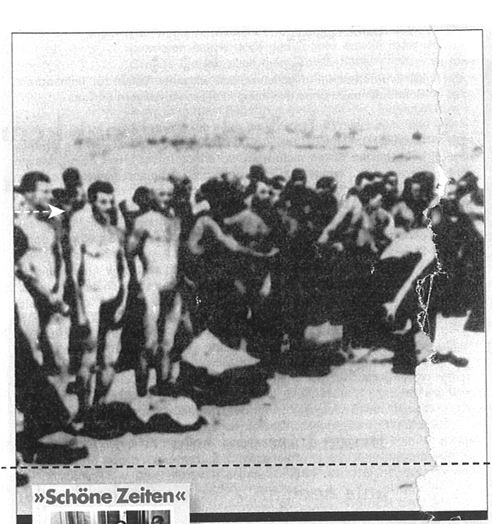
Fake: picture cropped to conceal bathing suit
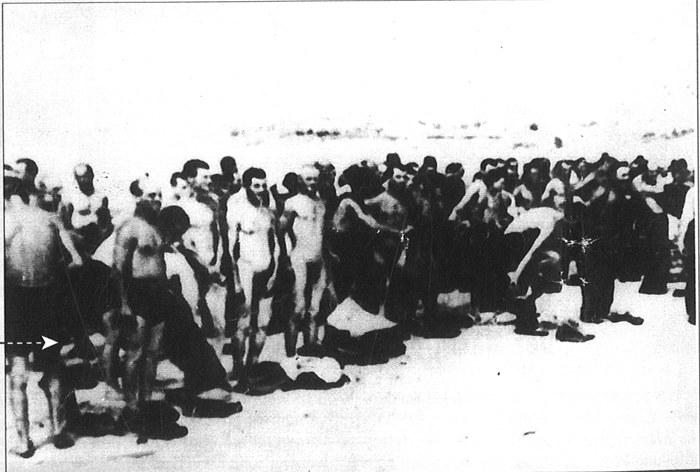
Another fake: bathing suit blacked out
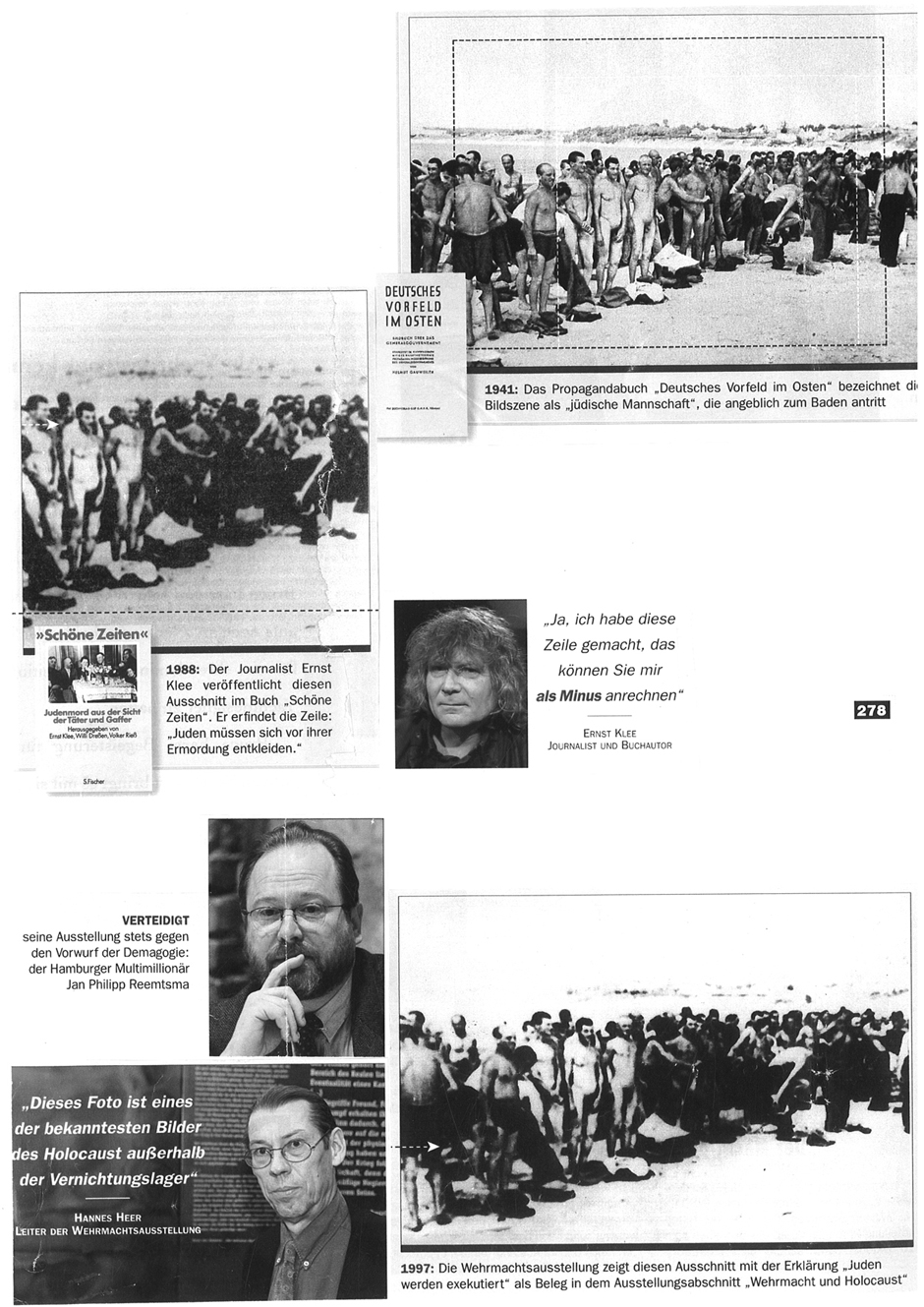
Multi-millionaire Jan Philipp Reemstra and agitator Hannes Heer together organized and the anti-German Army exhibition which travelled all over Germany in 1997, with the praise and support of the media and public authorities. The exhibition featured a mixture of complete lies and half-truths, as well as the depiction of events taken out of context or lacking all substantiation. The photographic material, most of it retouched, is of Soviet origin, taken by unknown persons, undated and without any indication as to where they were taken.
(The Magazine) Focus number 16/17 succeeded in showing the manner in which a photo from the book ‘Deutsches Vorfeld im Osten’, 1941, showing Jews bathing, was misused by German journalists and historians in 1988 to prove mass executions of Jews. In 1997, the Reemstra-Heer duo included this photo in their anti-German Army exhibition against better knowledge.
(Captions)
(The propaganda book ‘Deutsches Vorfeld im Osten’, calls this picture, Jewish work crews, allegedly going bathing.)
1988: The journalists Ernst Klee published this extract in his book ‘Schöne Zeiten’ (The Good Old Days). The caption ‘Jews being forced to undress prior to execution’ was simply invented by him.
(Translation of book title: The Good Old Days: The Genocide of the Jews as Seen by the Murderers and On Lookers.)
‘Yes, I made those lines up, you can count that against me as a MINUS.’-
ERNST KLEE, journalists and author, defending his exposition against the accusation of demagoguery: the Hamburg multi-millionaire Jan Philipp Reemstra. [?]
‘This photo is one of the best-known images of the Holocaust outside the concentration camps.’
Hannes Heer, Director of the Wehrmacht exposition.
1997: The Wehrmacht exposition shows this extract with the caption: ‘Jews being executed’, as proof in the section of the exposition entitled ‘Wehrmacht and Holocaust.
(Note: in the original photograph, the man to the left of the man covering his genitals is very clearly wearing a bathing suit, as is the man with his back to the camera at the left. This has all been blacked out, apparently with a paint brush, in the extract shown in the exposition.)
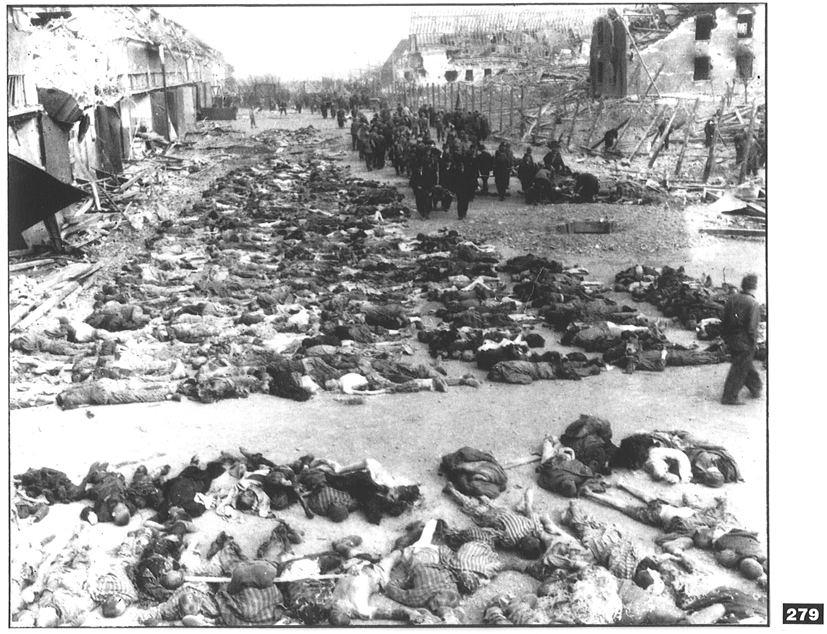
(279) The US weekly magazine Life (21/05/1945, page 36), comments: ‘The bodies of almost 3,000 slave laborers being buried by US soldiers. These dead worked in underground factories in the manufacture of V1 and V2 rockets.
In actual fact, these dead were the victims of the US terror attack on Nordhausen on 4 April 1945. Although the war was almost over, German cities continued to be bombed. Thus, the city of Nordhausen was bombed and almost totally destroyed on 4 April (2 days before the evacuation of the camp to Bergen-Belsen), also destroying the Boelke barracks in which the inmates were being housed. (From the series of publications from the Vierteljahreshefte für Zeitgeschichte, number 21, Stuttgart page 194, Prof. Martin Broszat).
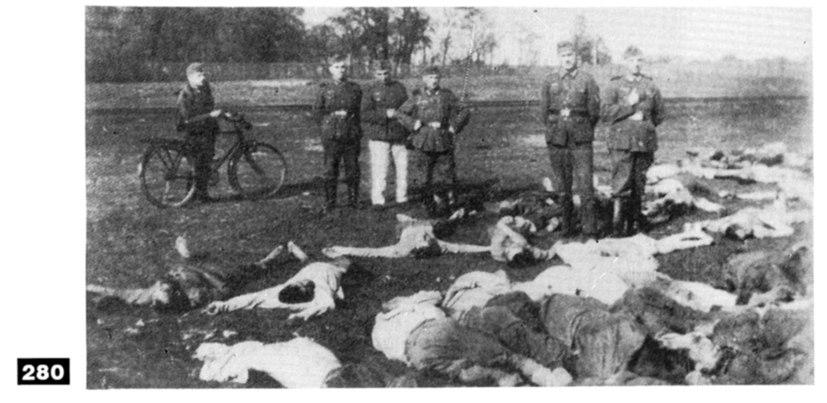
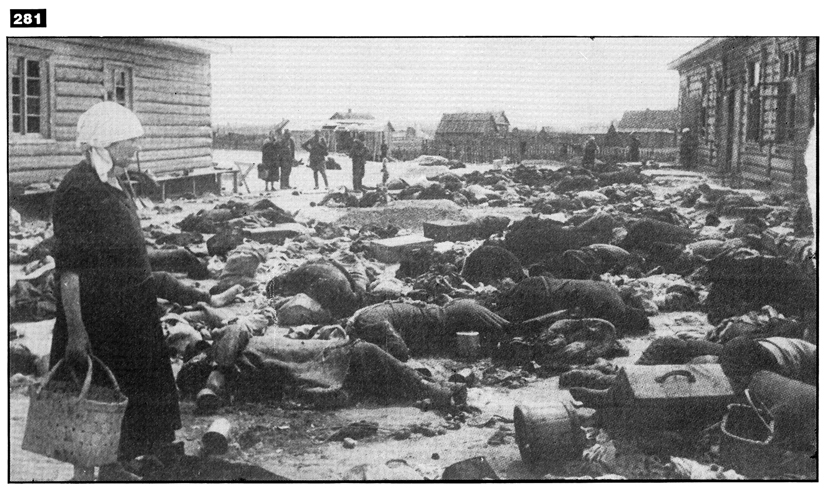
(280) (281) Photos from the National Archives of the October Revolution and the National Photographic and Film Archives in Krasnogorsk. The photos are supposed to have been found on German soldiers and are said to illustrate the mass execution of Russians.
It is hardly conceivable that German soldiers could be stupid as to run around the front line carrying proof of their crimes.
‘The staff of the Supreme Commander hereby issues the following order:
- All settlements in which German troops are located are to be destroyed and burnt to a depth of 40 – 60 kilometers from the main front line and 20 – 30 kilometers to the right and the left of all roads. The destruction of the settlements to the above indicated radius is to be carried out by the air force and artillery using grenade launchers, over large surface areas, as well as by political education squads, ski troops and partisan divisions, equipped with bottles of inflammable liquids.
- For this purpose, fighter defense squads are to be formed within every regiment, to a strength of 20 to 30 men, responsible for causing explosions and setting fire to the settlements. Courageous fighters must be selected for these actions to destroy the settlements.
(National Archives, Washington, Archive Series 429, roll 461, General Staff of the Army, Division Foreign Army East II H 3/70 Fr 6439568)
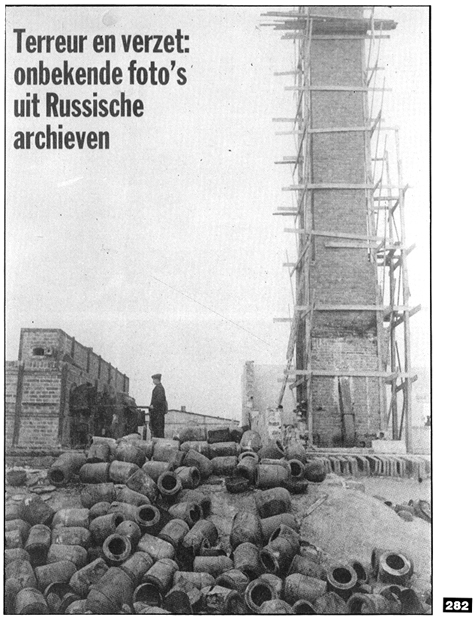
(282) Same origin as in photos 280 and 281. The commentary of the Dutch weekly Vim Nederlands (29/06/1991) reads: ‘The crematoria of Majdanek camp. Zyklon B containers lie around nearby.’ In reality, these containers appear to be funereal urns for the ashes of cremated persons.
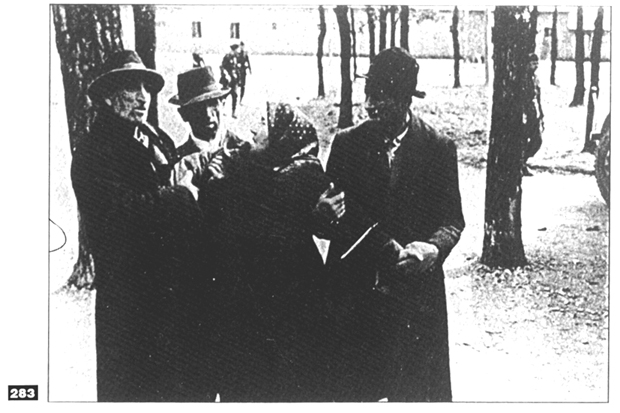
(283) This photo is typical of the difference in mentality between ‘exterminationists’ (defenders of the genocide myth) and revisionists.
Jean-Claude Pressac describes this photos as ‘a very important photograph’, (correctly) placing the scene between Krema IV and V. According to Pressac, 3 Hungarian Jews are gently forcing an elderly woman towards the entrance to Krema V, where they will all be gassed and cremated together. Pressac says: ‘As for the woman’s attitude, it could simply be that she, with no illusion about what is to happen and having seen the SS photographer, suddenly turned away, saying in effect, ‘I don’t want that bastard of an SS to photograph me’.
Robert Faurisson sarcastically answers that Pressac must be under the influence of drugs from his own pharmacy.
The photos shows 3 men and 1 woman in distress, while a few German soldiers walk uninterestedly past in the background (without truncheons or dogs). In actual fact, the photo shows nothing remarkable and proves nothing. None of them is wearing a camp uniform; it could have been photographed in a public park for all we know. Perhaps she is ill; perhaps she has just received news of the death of a loved one; or, more likely, perhaps she has just been caught stealing, picking pockets, or swindling on the black market.
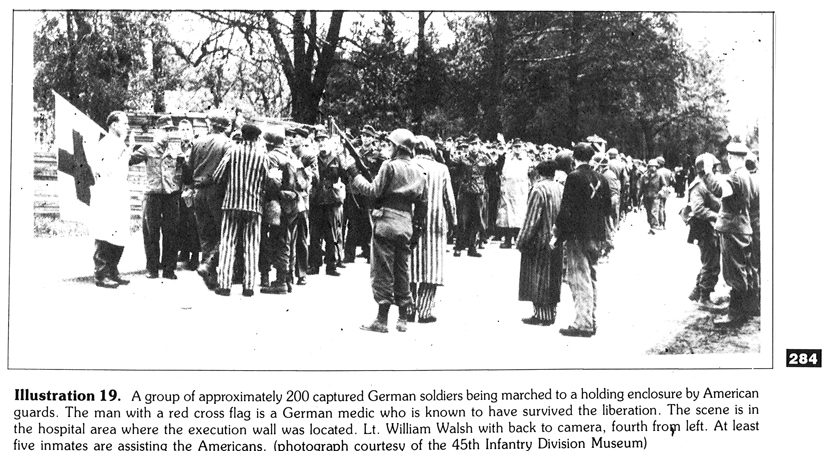
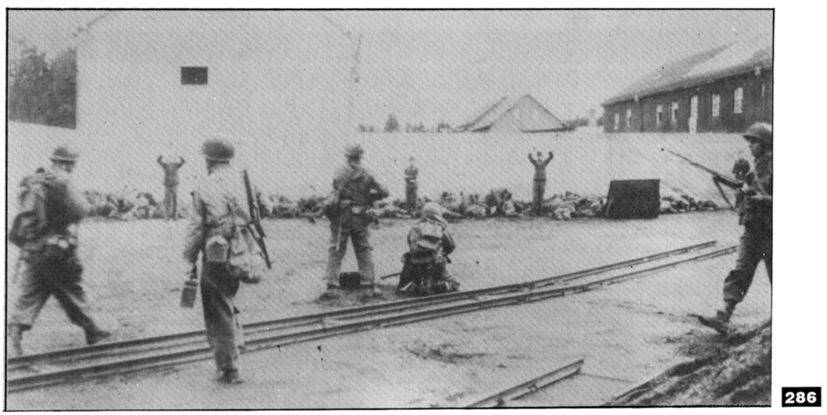
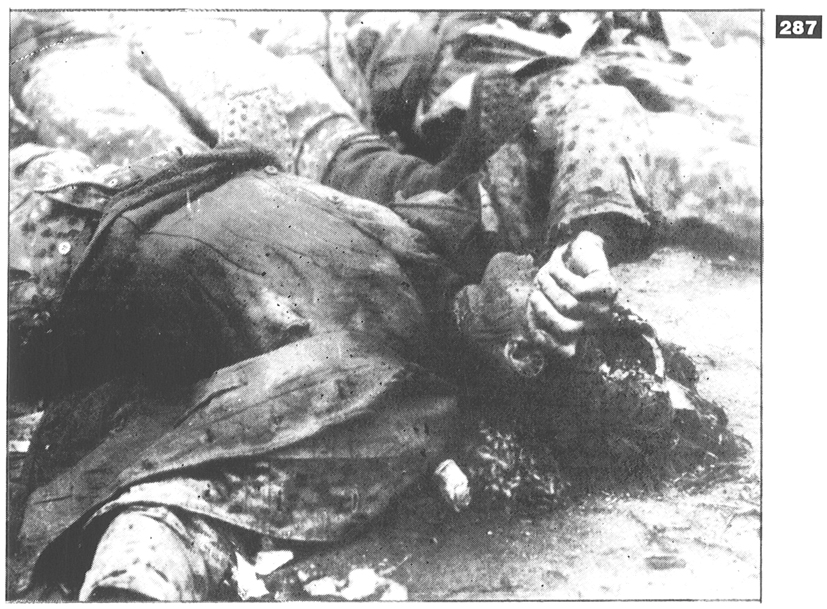
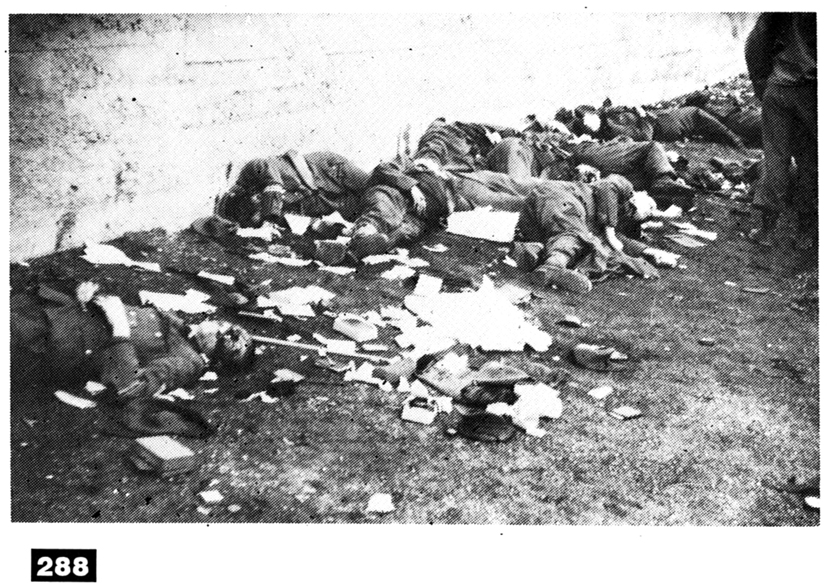
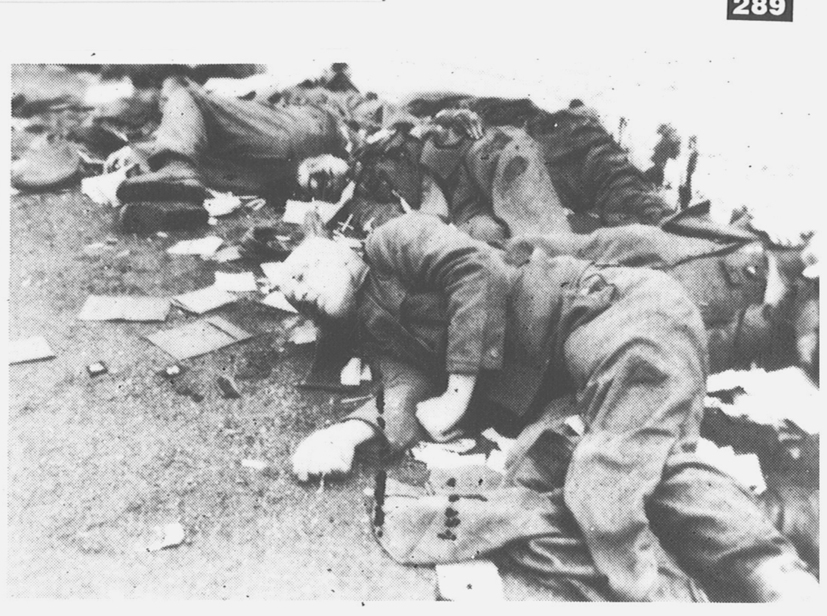
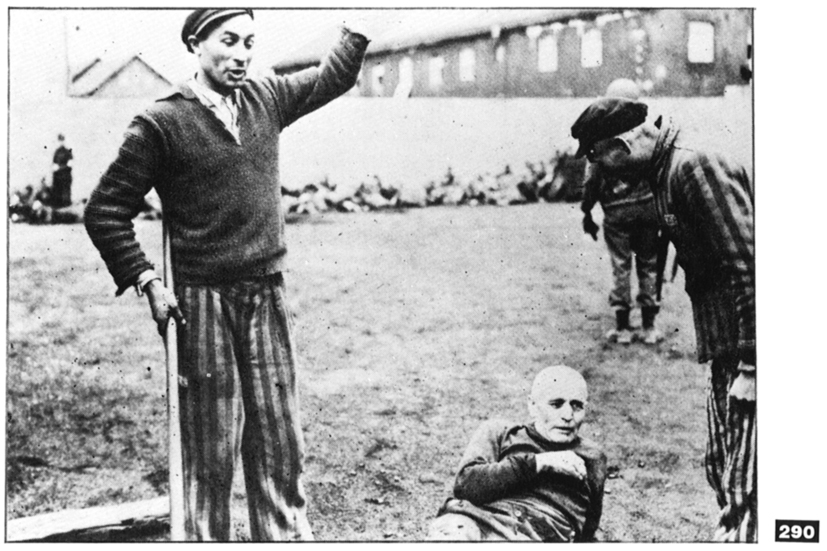
(284 – 290) From ‘Dachau: The Hour of the Avenger’ (Col. Howard A. Buechner), Thunderbird Press, Metairie, LA. USA, 1986.
During the liberation of Dachau camp, many German soldiers from the surrounding area surrendered under the protection of a medic with a Red Cross flag. The photo also shows members of the Volksturm, mountain troops, Luftwaffe personnel, Wehrmacht, SS soldiers in camouflage, soldiers in civilian clothing, etc….
Inmates inciting American troops to murder the German prisoners Lt. Walsh placed his division under the command of Lt. Bushyhead (nickname Bird’s Eye) of Native American Indian origin, to guard the prisoners.
Lt. Bushyhead placed the prisoners against the wall of the hospital and shot them with a few salvos of machine gun fire, giving inmates pistols in order to finish off the survivors. The bodies were looted. No action was taken by the Americans to prevent the inmates from taking revenge upon German personnel. The middle- aged man shown here was killed by inmates with a shovel, this is the same man seen lying dead along the wall holding a crucifix in his hand.
General Patton was informed of this massacre, but ordered the evidence destroyed and prohibited any further investigation. No one ever prosecuted for the murder of the 346 German soldiers interned at Dachau, who were entitled to protection under the Hague convention. Dachau was surrendered in full accordance with the terms of international law.
That the murder victims were members of the camp guard personnel is simply a lie, the photographs show soldiers from all German units. Even the camp personnel were not all criminals per se.
END OF TEXT










































